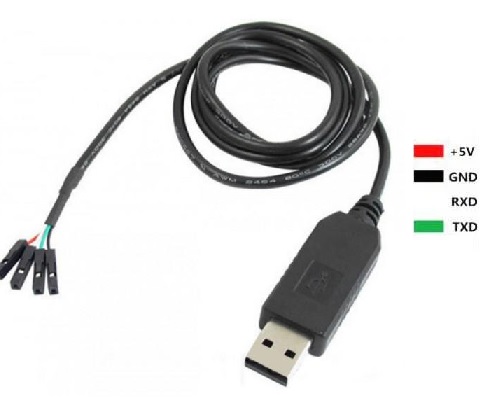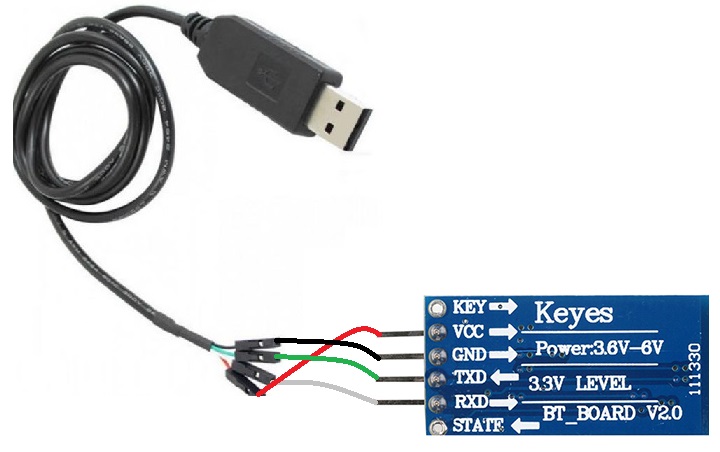AED 19.50
Description
The USB to TTL Serial Converter PL2303HX Cable Module is a device that allows you to connect your computer to a serial TTL device, such as an Arduino or other microcontroller, via a USB port. It has a 4-pin header that includes power, ground, RX, and TX pins, and uses the PL2303HX chipset for serial communication. The cable is 1 meter long, which provides flexibility and convenience in connecting to your device.
Package Includes:
- 1 x USB to TTL Serial Converter PL2303HX Cable Module 1m
Features:
- Easy connectivity: The USB to TTL serial converter module allows for easy connectivity between a TTL serial device and a computer via a USB port.
- Plug and play: The module is designed to be a plug-and-play device, which means it doesn't require any special drivers or software to be installed.
- High data transfer rate: The module supports a wide range of baud rates (from 75 to 128000) and USB 2.0 full-speed mode, ensuring high-speed data transfer between the devices.
- Wide compatibility: The module is compatible with a variety of operating systems, including Windows, Mac, Linux, and Android.
- Long cable length: The 1-meter long cable provides flexibility and convenience in connecting to the device being controlled.
- Durable design: The module is made of high-quality materials, which ensures its durability and long service life.
- Support for flow control: The module supports flow control protocols like Xon/Xoff and RTS/CTS, which help in managing data flow between the devices.
- Automatic handshake protocol support: The module supports automatic handshake protocols, which makes communication between devices smoother and more reliable.
- Remote wake-up and power management support: The module supports remote wake-up and power management, which makes it a power-efficient device.
Description:
The PL2303HX chipset is a popular solution for USB to serial conversion due to its reliable performance and ease of use. This converter cable module also supports a wide range of operating systems, including Windows, Mac, Linux, and Android, which makes it a versatile tool for developers, hobbyists, and makers. The cable module can be used for a variety of applications, including debugging, programming, and communication with other devices. It is a useful tool for anyone who needs to connect a TTL serial device to a computer or other host device.
Principle of Work:
The 1m 4 pins USB to TTL Serial Converter PL2303HX Cable Module works by converting the TTL (Transistor-Transistor Logic) level signals from a serial device to the USB (Universal Serial Bus) level signals that a computer can understand. It uses the PL2303HX chipset to facilitate this conversion. When the module is connected to a computer via a USB port, the computer recognizes it as a COM port, and the user can communicate with the connected serial device as if it were directly connected to the computer's serial port. The module receives data from the serial device via the RX pin, converts it into USB signals, and sends it to the computer. Similarly, it receives data from the computer via USB signals, converts it into TTL signals, and sends it to the serial device via the TX pin. The PL2303HX chipset used in this module is designed to handle serial communication and is compatible with a wide range of operating systems, including Windows, Mac, Linux, and Android. It supports a variety of data formats, baud rates, flow control protocols, and automatic handshake protocols, making it a versatile and reliable tool for serial communication.
Pinout:

- VCC: provides power to the device being connected (usually 5V)
- GND: provides a ground connection for the device
- RX: receives data from the device
- TX: transmits data to the device
Applications:
- Programming and debugging microcontrollers: The module can be used to program and debug microcontrollers that use a TTL serial interface, such as Arduino, ESP32, and Raspberry Pi.
- Industrial automation and control: The module can be used to communicate with various industrial equipment and devices, such as sensors, actuators, and programmable logic controllers (PLCs).
- Robotics and automation: The module can be used to communicate with various robotic systems and automation devices that use a TTL serial interface.
- Communication and networking: The module can be used to establish serial communication between different devices, such as computers, microcontrollers, and sensors, over a USB connection.
- Home automation: The module can be used to control various home automation systems and devices that use a TTL serial interface, such as smart home devices, sensors, and security systems.
- Education and research: The module can be used as a tool for educational and research purposes, such as learning about serial communication, studying different protocols, and developing new applications.
Circuit:
To connect an HC-06 module to a PL2303 USB to Serial Bridge Controller, connect the following pins:
- HC-06 TXD (gray or white wire) to PL2303 RXD (green wire)
- HC-06 RXD (green wire) to PL2303 TXD (white wire)
- HC-06 GND (black wire) to PL2303 GND (black wire)
- HC-06 VCC (red wire) to PL2303 VCC (red wire)
- The PL2303 controller will act as a bridge between the HC-06 module and a computer, allowing serial communication over a USB connection.

Drivers needed:
- you might need to install one of two drivers depending on your system :
- First Driver:
-
https://www.ifamilysoftware.com/Prolific_PL-2303_Code_10_Fix.html
- Download https://www.ifamilysoftware.com/Drivers/PL2303_64bit_Installer.exe
- Unplug all USB-To-Serial adapters and Double click on the installer "PL2303_64bit_Installer.exe". This file can be deleted later.
- The "PL2303 Code 10 Fix" program will be installed along with a shortcut on your Windows Desktop.
- Double click on the "PL2303 Code 10 Fix Shortcut"5. Plug in one (1) of your USB-To-Serial adapters and click "Continue".
- When it finishes, Reboot your computer.
- Unplug the adapter and plug back in again. That's it!
- Secon Driver:
-
- Download https://github.com/johnstevenson/pl2303-legacy/releases/download/1.1.0/PL2303LegacyUpdaterSetup-1.1.0.exe
- run the application
- connect the device, Select Legacy PL2303 HXA/XA, click next
- Then finish the setup.
Example:
To communicate with an Android phone and a PC using the HC-06 module and the serial converter, this process involves setting up a Bluetooth connection between the Android phone and the HC-06 module and using the serial converter to bridge the communication between the phone and the PC via the TX and RX pins you can follow these steps:
- Connect the HC-06 module to the serial converter as described in the previous answer, making sure that the TX and RX pins are connected properly.
- Connect the serial converter to the PC via a USB port, and install the necessary drivers for the PL2303 chipset if needed.
- Install a terminal emulator app on your Android phone, such as Termux, Serial Bluetooth Terminal, or BlueTerm.
- Pair your Android phone with the HC-06 module via Bluetooth. You may need to enter a PIN code to complete the pairing process (0000 or 1234 as default).
- Open the terminal emulator app on your Android phone, and set the baud rate, data bits, stop bits, and parity bits to match the settings of the serial converter.
- Send commands or data from the Android phone to the serial converter by typing them into the terminal emulator app and pressing enter. The commands or data will be transmitted to the HC-06 module via Bluetooth, and then to the serial converter via the TX pin.
- Receive data from the PC on your Android phone by sending commands or data from the terminal emulator app to the serial converter via the TX pin. The data will be transmitted to the HC-06 module via Bluetooth, and then to the Android phone for display in the terminal emulator app.
Technical Details:
- Built-in TTL COM PC-PL2303HX chip
- USB type A male connector
- TTL 4-pin connector (VCC, GND, RX, TX)
- Cable length: 100 cm (39 3/8 inch)
- Supports baud rate from 75 to 128000
- Supports Linux, Mac OS, Windows, and Windows CE
- PL2303HX USB to serial controller adopted
- Cable pitch: 2.54mm pitch type
- Color: Black
- Operating temperature: -40°C to 85°C
- Supports automatic handshake protocol
- Supports remote wake-up and power management
- Supports USB 2.0 full-speed mode
- Supports data format: 8 data bits, 1 stop bit, and parity bit
- Supports flow control: Xon/Xoff, RTS/CTS
Resources:
- Tutorial
- https://www.ifamilysoftware.com/Prolific_PL-2303_Code_10_Fix.html
- Download https://github.com/johnstevenson/pl2303-legacy/releases/download/1.1.0/PL2303LegacyUpdaterSetup-1.1.0.exe
- https://github.com/johnstevenson/pl2303-legacy
Comparisons:
The PL2303HX and FTDI232 are both USB to TTL serial converters that can be used to communicate with microcontrollers, sensors, and other electronic devices. Here are some comparisons between the two:
- Chipset: The PL2303HX uses a PC-PL2303HX chip, while the FTDI232 uses an FTDI FT232RL chip. Both chips are widely used and have good driver support, but the FTDI232 is generally considered to be more reliable and compatible with a wider range of operating systems.
- Pinout: The PL2303HX and FTDI232 have slightly different pinouts. For example, the DTR pin on the PL2303HX is not available.
- Baud rate: The PL2303HX supports a wider range of baud rates (75 to 128000) compared to the FTDI232 (300 to 115200), which may be useful for some applications.
- Price: The PL2303HX is generally less expensive than the FTDI232, which may be a consideration for budget-conscious projects.
- Compatibility: The FTDI232 is known to have better compatibility with some specialized hardware and software, such as certain radio equipment and programming tools, than the PL2303HX.